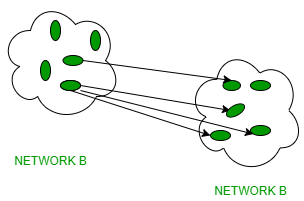
The world of computer networks has a variety of communication mechanisms and protocols that provide a set of guidelines and rules to be followed while transmitting data from one node to another. These mechanisms and protocols determine the efficiency and reliability of the inter-connected and intra-connected network systems. In this article, we’ll learn about the difference between two of the most commonly used message distribution mechanisms – Broadcast and Multicast- shedding light on their unique characteristics.
Broadcast and a Multicast are two different communication mechanism in computer networks for transmitting data between the nodes in a network.
Broadcast transfer (one-to-all) techniques and can be classified into two types : Limited Broadcasting and direct Broadcasting. In broadcasting mode, transmission happens from one host to all the other hosts connected on the LAN. In simple words, broadcasting is a communication mechanism where data is sent to all the nodes in a network. The broadcast address is a special reserved address bit for broadcasting messages in a network. We can calculate the broadcast address given its IP address and the subnet Mask.
Devices such as bridges use boradcast. A protocol like ARP implements this, in order to know the MAC address for the corresponding IP address of the host machine. ARP does IP address to MAC address translation. RARP does the reverse.

Multicasting has one/more senders and one/more recipients participate in data transfer traffic. In multicasting traffic recline between the boundaries of unicast and broadcast. It server’s direct single copies of data streams and that are then simulated and routed to hosts that request it. IP multicast requires support of some other protocols such as IGMP (Internet Group Management Protocol), Multicast routing for its working. And also in Classful IP addressing Class D is reserved for multicast groups.

It increases network traffic because the data packets are sent to every other node in the network.
It doesn’t increase network traffic.
The message to be sent should be tripled checked as some sensitive or confidential information shouldn’t be distributed to everyone in the network.
No such issue, because the message is target to only selected people.
It is essential to understand the differences between broadcast and multicast in order to maximize network performance. Sending data via broadcast to every device on a network segment can result in inefficiencies, particularly in bigger networks. Conversely, multicast is more effective and scalable when it comes to distributing data to numerous recipients at once because it targets particular groups.
Yes, depending on the particular requirements of the applications and the network architecture, broadcast and multicast can be employed in the same network for different purposes.
Multicast is utilized in situations like online gaming, live streaming, and video conferencing where the same data needs to be sent to several recipients.
When it comes to server load reduction, scalability, and bandwidth utilization, multicast outperforms broadcast for large-scale data communication.